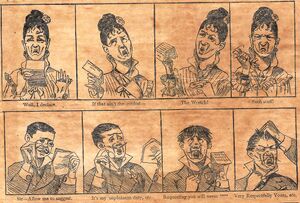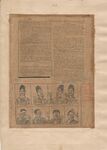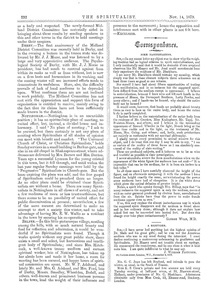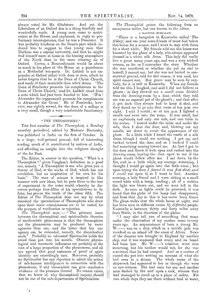HPB-SB-10-123: Difference between revisions
mNo edit summary |
mNo edit summary |
||
| Line 31: | Line 31: | ||
| item =1 | | item =1 | ||
| type =Correspondence | | type =Correspondence | ||
| status = | | status = proofread | ||
| continues = | | continues = | ||
| author =Fletcher, J. William | | author =Fletcher, J. William | ||
| title =A Rejoinder | | title =A Rejoinder | ||
| subtitle = | | subtitle = | ||
| untitled = | | untitled = | ||
| source title =Spiritualist | | source title = London Spiritualist | ||
| source details = | | source details = No. 377, November 14, 1879, p. 232 | ||
| publication date =1879-10-14 | | publication date = 1879-10-14 | ||
| original date = | | original date = 1879-11-08 | ||
| notes = | | notes = | ||
| categories = | | categories = | ||
}} | }} | ||
... | {{Style S-Small capitals| Sir}},—I have never had anything but the highest opinion of Dr. Slade and his great gifts; and he was ''not ''the American medium who was in my mind during the interview. I must decline continuing a controversy unbecoming to gentlemen and Spiritualists. Mr. Massey need not trouble about an apology. He commenced the controversy, and he can close it when it best suits him. I am quite indifferent to what he may say. | ||
J. William Fletcher. | |||
22, Gordon-street, London, W.C., November 8, 1879. | |||
{{HPB-SB-item | {{HPB-SB-item | ||
| Line 52: | Line 56: | ||
| item =2 | | item =2 | ||
| type =article | | type =article | ||
| status = | | status = proofread | ||
| continues = | | continues = 124 | ||
| author = | | author = | ||
| title ="The Theosophist" | | title ="The Theosophist" | ||
| subtitle = | | subtitle = | ||
| untitled = | | untitled = | ||
| source title =Spiritualist | | source title = London Spiritualist | ||
| source details = | | source details = No. 377, November 14, 1879, p. 234-35 | ||
| publication date =1879- | | publication date = 1879-11-14 | ||
| original date = | | original date = | ||
| notes = | | notes = | ||
| Line 66: | Line 70: | ||
}} | }} | ||
... | {{Style S-Small capitals| The}} first number of ''The Theosophist, ''a Bombay monthly periodical, edited by Madame Blavatsky, was published in India on the first of October. It is a large, well-printed journal, full of interesting reading, much of it contributed by natives of India, and affording an insight into the religious thought of the far East. | ||
The Editor, in answer to the question, “What is a Theosophist?” gives Vaughan’s definition as a good one, namely, “A Theosophist is one who gives you a theory of God, or the works of God, which has not revelation, but an inspiration of his own for his basis.” The man of science is inspired in like manner with new ideas, but he puts them to the test of experiment in the outer world, whereby he discovers perhaps four-fifths of his speculations to be false, but proves the truth of the other fifth. The Editor of ''The Theosophist ''does not say by what standard the speculations of Theosophists who draw upon their inner consciousness are to be tested, for the purpose of verification or rejection. | |||
''The Theosophist ''says: — “The primary issue between the theosophical and spiritualistic theories of mediumistic phenomena is that the theosophists say the phenomena may be produced by more agencies than one, and the latter that but one agency can be conceded, namely, the disembodied souls.” Probably no educated Spiritualist holds the creed thus put into his mouth. Obscure physiological and mesmeric influences are probably at the root of a large proportion of the phenomena, and all are agreed that good instances of proof of spirit identity are exceedingly rare. Moreover, probably no Spiritualist has any objection to admit the action of sub-human intelligences in connection with the phenomena, if any theosophist can give conclusive evidence of the presence thereof. No reason exists, that we know of, why theosophical inquiry should not be one of the sub-departments of Spiritualism. | |||
{{Style S-HPB SB. Continues on|10-124}} | |||
{{HPB-SB-item | {{HPB-SB-item | ||
| Line 86: | Line 96: | ||
{{HPB-SB-footer-footnotes}} | {{HPB-SB-footer-footnotes}} | ||
{{HPB-SB-footer-sources}} | |||
<gallery widths=300px heights=300px> | |||
london_spiritualist_n.377_1879-11-14.pdf|page=6|London Spiritualist, No. 377, November 14, 1879, p. 232 | |||
london_spiritualist_n.377_1879-11-14.pdf|page=8|London Spiritualist, No. 377, November 14, 1879, p. 234-35 | |||
</gallery> | |||
Latest revision as of 08:55, 16 August 2024
< Form Manifestations (continued from page 10-122) >
It would seem, however, that hands are probably about twenty times as easy to form as the entire body, and hence the entire body is rarely completed.
I further believe in the materialisation of the entire body from the evidence of Mr. Crookes, Miss Kislingbury, Mr. Tapp, Mr. Stainton-Moses, and others; and I believe in the astounding appearance of Samuel Wheeler in the light, Monck being at t lie same time visible and in the light, on the testimony of Mr. Moses, Mrs. Going, and others; and, lastly, such productions are entirely in conformity with my spiritual philosophy.
I gladly accept every permission to attend seances for this object, and I do trust that 011c day I may be able to say, “I am as certain of the reality of these forms as 1 am absolutely convinced of the reality of slate-writing.”
These are profound subjects, and it behoves us to be as wise and truthful as possible in their investigation.
I never attended a seance for form manifestations when on the appearance of the white figure the audience has not said-—“It is impossible that can be the medium, for it is from six inches to a foot taller.”
In all these eases I bare carefully observed the height of the figure, and on afterwards comparing it with the medium I have found the height exactly the same, notwithstanding the power some mediums have had of elongation. It is the white dress which gives the optical delusion of greater height.
Nolan, a spirit who speaks through Mrs. Billing, says that “in many instances the supposed spirit is only the medium, covered with an outer garment produced by electric force, manufactured from the air. Spirits have thus the power to make female mediums appear even as men.”
If so, this may explain the almost instantaneous way in which the supposed spirit disappears and the medium is found alone and in her ordinary dress; although it does not explain how naked feet can be converted into booted feet. But docs this change ever take place instantaneously?
A Rejoinder
Sir,—I have never had anything but the highest opinion of Dr. Slade and his great gifts; and he was not the American medium who was in my mind during the interview. I must decline continuing a controversy unbecoming to gentlemen and Spiritualists. Mr. Massey need not trouble about an apology. He commenced the controversy, and he can close it when it best suits him. I am quite indifferent to what he may say.
J. William Fletcher.
22, Gordon-street, London, W.C., November 8, 1879.
"The Theosophist"
The first number of The Theosophist, a Bombay monthly periodical, edited by Madame Blavatsky, was published in India on the first of October. It is a large, well-printed journal, full of interesting reading, much of it contributed by natives of India, and affording an insight into the religious thought of the far East.
The Editor, in answer to the question, “What is a Theosophist?” gives Vaughan’s definition as a good one, namely, “A Theosophist is one who gives you a theory of God, or the works of God, which has not revelation, but an inspiration of his own for his basis.” The man of science is inspired in like manner with new ideas, but he puts them to the test of experiment in the outer world, whereby he discovers perhaps four-fifths of his speculations to be false, but proves the truth of the other fifth. The Editor of The Theosophist does not say by what standard the speculations of Theosophists who draw upon their inner consciousness are to be tested, for the purpose of verification or rejection.
The Theosophist says: — “The primary issue between the theosophical and spiritualistic theories of mediumistic phenomena is that the theosophists say the phenomena may be produced by more agencies than one, and the latter that but one agency can be conceded, namely, the disembodied souls.” Probably no educated Spiritualist holds the creed thus put into his mouth. Obscure physiological and mesmeric influences are probably at the root of a large proportion of the phenomena, and all are agreed that good instances of proof of spirit identity are exceedingly rare. Moreover, probably no Spiritualist has any objection to admit the action of sub-human intelligences in connection with the phenomena, if any theosophist can give conclusive evidence of the presence thereof. No reason exists, that we know of, why theosophical inquiry should not be one of the sub-departments of Spiritualism.
<... continues on page 10-124 >

Editor's notes
Sources
-
London Spiritualist, No. 377, November 14, 1879, p. 232
-
London Spiritualist, No. 377, November 14, 1879, p. 234-35



